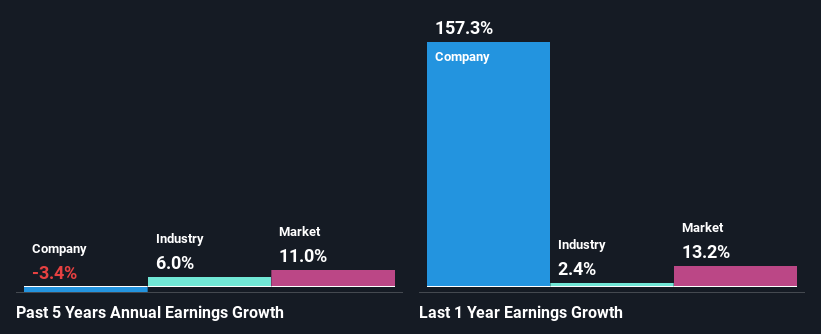QinetiQ Group plc's (LON:QQ.) Stock On An Uptrend: Could Fundamentals Be Driving The Momentum?
QinetiQ Group (LON:QQ.) has had a great run on the share market with its stock up by a significant 15% over the last month. We wonder if and what role the company's financials play in that price change as a company's long-term fundamentals usually dictate market outcomes. Specifically, we decided to study QinetiQ Group's ROE in this article.
Return on equity or ROE is a key measure used to assess how efficiently a company's management is utilizing the company's capital. Simply put, it is used to assess the profitability of a company in relation to its equity capital.
See our latest analysis for QinetiQ Group
How Is ROE Calculated?
Return on equity can be calculated by using the formula:
Return on Equity = Net Profit (from continuing operations) ÷ Shareholders' Equity
So, based on the above formula, the ROE for QinetiQ Group is:
17% = UK£180m ÷ UK£1.0b (Based on the trailing twelve months to September 2022).
The 'return' refers to a company's earnings over the last year. So, this means that for every £1 of its shareholder's investments, the company generates a profit of £0.17.
What Is The Relationship Between ROE And Earnings Growth?
We have already established that ROE serves as an efficient profit-generating gauge for a company's future earnings. Depending on how much of these profits the company reinvests or "retains", and how effectively it does so, we are then able to assess a company’s earnings growth potential. Generally speaking, other things being equal, firms with a high return on equity and profit retention, have a higher growth rate than firms that don’t share these attributes.
A Side By Side comparison of QinetiQ Group's Earnings Growth And 17% ROE
To start with, QinetiQ Group's ROE looks acceptable. On comparing with the average industry ROE of 13% the company's ROE looks pretty remarkable. As you might expect, the 3.4% net income decline reported by QinetiQ Group is a bit of a surprise. Therefore, there might be some other aspects that could explain this. These include low earnings retention or poor allocation of capital.
That being said, we compared QinetiQ Group's performance with the industry and were concerned when we found that while the company has shrunk its earnings, the industry has grown its earnings at a rate of 6.0% in the same period.
The basis for attaching value to a company is, to a great extent, tied to its earnings growth. What investors need to determine next is if the expected earnings growth, or the lack of it, is already built into the share price. Doing so will help them establish if the stock's future looks promising or ominous. Has the market priced in the future outlook for QQ.? You can find out in our latest intrinsic value infographic research report.
Is QinetiQ Group Using Its Retained Earnings Effectively?
Despite having a normal three-year median payout ratio of 32% (where it is retaining 68% of its profits), QinetiQ Group has seen a decline in earnings as we saw above. So there could be some other explanations in that regard. For instance, the company's business may be deteriorating.
Additionally, QinetiQ Group has paid dividends over a period of at least ten years, which means that the company's management is determined to pay dividends even if it means little to no earnings growth. Upon studying the latest analysts' consensus data, we found that the company is expected to keep paying out approximately 30% of its profits over the next three years. Still, forecasts suggest that QinetiQ Group's future ROE will drop to 13% even though the the company's payout ratio is not expected to change by much.
Summary
Overall, we feel that QinetiQ Group certainly does have some positive factors to consider. Although, we are disappointed to see a lack of growth in earnings even in spite of a high ROE and and a high reinvestment rate. We believe that there might be some outside factors that could be having a negative impact on the business. With that said, we studied current analyst estimates and discovered that analysts expect the company's earnings growth to improve slightly. This could offer some relief to the company's existing shareholders. To know more about the latest analysts predictions for the company, check out this visualization of analyst forecasts for the company.
Have feedback on this article? Concerned about the content? Get in touch with us directly. Alternatively, email editorial-team (at) simplywallst.com.
This article by Simply Wall St is general in nature. We provide commentary based on historical data and analyst forecasts only using an unbiased methodology and our articles are not intended to be financial advice. It does not constitute a recommendation to buy or sell any stock, and does not take account of your objectives, or your financial situation. We aim to bring you long-term focused analysis driven by fundamental data. Note that our analysis may not factor in the latest price-sensitive company announcements or qualitative material. Simply Wall St has no position in any stocks mentioned.
Join A Paid User Research Session
You’ll receive a US$30 Amazon Gift card for 1 hour of your time while helping us build better investing tools for the individual investors like yourself. Sign up here

 Yahoo Finance
Yahoo Finance 
